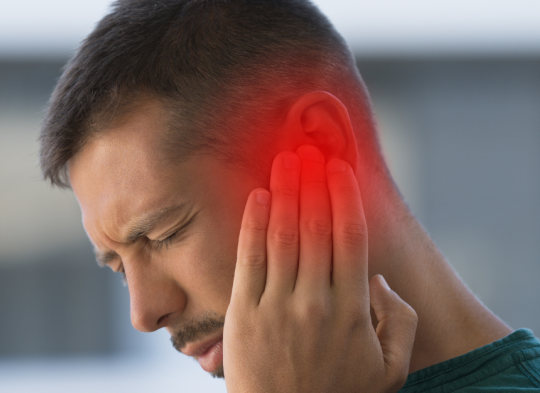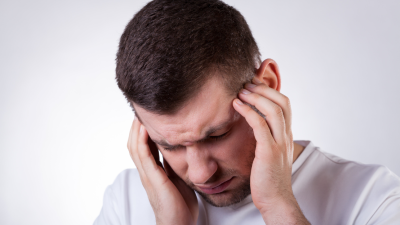The most common causes of earache include inflammation, buildup of earwax, mechanical irritations, and upper respiratory infections.
While home remedies can provide temporary relief and ease discomfort, they are not always sufficient. That’s why it’s important to know which methods are safe and when it’s necessary to consult a doctor.
If you are experiencing ear pain and home remedies do not bring relief, contact us. In our private clinic in London, we offer ENT consultations, safe earwax removal, and treatment of ear infections in children and adults.
This article presents proven and safe home remedies for earache.
Most common causes of earache
Ear pain can have many sources, so it’s always helpful to consider additional accompanying symptoms. The main causes include:
-
Middle and outer ear infections
Usually develop after a cold, flu, or sinusitis.
Symptoms include pain, fever, a feeling of fullness in the ear, and sometimes discharge.
We provide tips on how to deal with ear infections in a separate article. -
Earwax buildup (earwax impaction)
Can cause a feeling of blockage, worsened hearing, ringing, and in some cases, pain. -
Mechanical irritations
Occur, for example, after using sharp objects for ear cleaning or frequent use of in-ear headphones.
These can lead to micro-injuries and inflammation. -
Upper respiratory infections
Cold, sore throat, or sinus problems often cause pain radiating to the ear.
We offer advice on caring for a child’s healthy throat in a separate article.
The pain results from the shared nervous system and anatomical connections. -
Pressure changes
Traveling by plane, diving, or rapid altitude changes can cause “barotrauma” of the ear, characterized by pain and a feeling of blockage.
It is crucial to identify the cause of ear pain because this determines whether home remedies will suffice or if a visit to the doctor is necessary.
Warm compress is a simple and effective home remedy for ear pain. Applying heat improves blood circulation in the area, which helps reduce inflammation and provides relief.
You can use a hot water bottle wrapped in a towel, an electric heating pad set to a low temperature, or even a bottle of warm water. It’s important that the compress is not too hot—excessively high temperatures could irritate the delicate skin around the ear.
The compress should be applied to the ear for several minutes, preferably while lying down, to ensure even distribution of warmth around the outer ear. Many people find that this treatment not only alleviates pain but also reduces the feeling of fullness in the ear and helps relax neck muscles that often tense up during inflammation.
Warm compresses are a safe method for adults and older children, but in the case of very young children, caution is needed to monitor the temperature.
Steam inhalation and humidifying the air
Ear pain frequently occurs during upper respiratory infections when blocked sinuses and nasal mucosa swelling cause increased pressure in the middle ear. In such cases, steam inhalation can be helpful; it moisturizes the airways, thins mucus, and facilitates drainage. You can inhale steam by breathing over a bowl of hot water covered with a towel or by using a traditional inhaler.
Adding saline solution to the water can assist, and with medical consultation, eucalyptus or mint oil can be added for decongestant effects.
Maintaining proper humidity in the room is also important. Dry air can irritate mucous membranes, worsening symptoms. Using a humidifier, hanging damp towels, or placing a bowl of water near the radiator are simple ways to improve breathing comfort and indirectly reduce ear pain related to infection.
Steam inhalation and humidity can significantly ease symptoms such as a feeling of ear blockage, radiating pain to the head, or difficulty breathing through the nose.
Over-the-counter pain relievers
For severe ear pain that impairs functioning, over-the-counter analgesics and anti-inflammatory medications can be helpful. Paracetamol or ibuprofen are most commonly used—they not only relieve pain but, in the case of ibuprofen, also reduce inflammation. These simple measures can decrease discomfort, improve sleep quality, and help with daily activities during illness.
However, it’s important to always follow the recommended doses listed on the package and adjust the medication to the patient's age. For children, selecting the appropriate product is best done in consultation with a pediatrician, especially if the ear pain appears suddenly or is accompanied by fever.
While painkillers can provide immediate relief, remember they do not treat the underlying cause of the problem.
Gentle rubbing or massaging the skin around the painful ear is a simple method that can provide relief in cases of mild pain. This technique improves microcirculation, relaxes tense muscles in the jaw and neck area, and reduces the sensation of pressure. Just softly massage the area behind the ear, the earlobe, and the skin along the jawline with slow, circular motions.
It’s helpful to read: Reflexology and Headache and Migraine Treatment.
This can be done using a plant-based oil with warming or relaxing properties, such as olive oil or lavender oil (provided there is no allergy). However, the rubbing should not involve strong pressure—gentle, light movements are recommended to avoid causing additional pain.
This method may be especially useful when ear pain accompanies upper respiratory infections and is also associated with tension in the jaw or neck.
When can home remedies be used for ear pain?
Home methods for alleviating ear pain are most effective when symptoms are mild and temporary.
If the symptoms appear suddenly but are not accompanied by fever, discharge, or significant hearing loss, you can try using a warm compress, steam inhalation, humidifying the air, or over-the-counter painkillers. These approaches often help when the pain is due to a cold, minor ear blockage, or mechanical irritation.
Remember that home remedies can support medical treatment—such as during respiratory infections when ear pain is a symptom. However, it’s essential to monitor symptoms. If the pain worsens, persists for more than 1–2 days, or if additional warning signs occur, stop self-treatment and consult a healthcare professional.
Summary
Home remedies for ear pain, such as warm compresses, steam inhalation, humidification, gentle massage around the ear, or using over-the-counter pain relievers, can effectively ease mild discomfort and improve daily functioning. However, these are temporary solutions and do not replace a medical diagnosis.
If ear pain lasts longer than two days, worsens, or is accompanied by fever, discharge, dizziness, or hearing loss, a visit to a specialist is necessary. Quick diagnosis and appropriate treatment can prevent complications and facilitate recovery.



